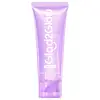What's inside
What's inside
 Key Ingredients
Key Ingredients

 Benefits
Benefits

 Concerns
Concerns

 Ingredients Side-by-side
Ingredients Side-by-side

Water
Skin ConditioningLauric Acid
CleansingStearic Acid
CleansingGlycerin
HumectantPotassium Hydroxide
BufferingButylene Glycol
HumectantPalmitic Acid
EmollientGlycol Distearate
EmollientCocamidopropyl Betaine
CleansingAcrylates Copolymer
Cocamide DEA
EmulsifyingSodium Laureth Sulfate
CleansingSodium Chloride
MaskingPotassium Cocoyl Glycinate
Phenoxyethanol
PreservativeChlorphenesin
AntimicrobialDisteardimonium Hectorite
StabilisingDisodium EDTA
Polyquaternium-7
Sodium Benzoate
MaskingSodium Hyaluronate
HumectantSodium Acetylated Hyaluronate
HumectantSorbitol
HumectantResveratrol
AntioxidantSargassum Muticum Extract
Skin ProtectingFucus Serratus Extract
Skin ProtectingGelidiella Acerosa Extract
Skin ProtectingHypnea Musciformis Extract
Skin ProtectingChondrus Crispus Extract
Skin ConditioningMethylparaben
PreservativePropylparaben
PreservativeWater, Lauric Acid, Stearic Acid, Glycerin, Potassium Hydroxide, Butylene Glycol, Palmitic Acid, Glycol Distearate, Cocamidopropyl Betaine, Acrylates Copolymer, Cocamide DEA, Sodium Laureth Sulfate, Sodium Chloride, Potassium Cocoyl Glycinate, Phenoxyethanol, Chlorphenesin, Disteardimonium Hectorite, Disodium EDTA, Polyquaternium-7, Sodium Benzoate, Sodium Hyaluronate, Sodium Acetylated Hyaluronate, Sorbitol, Resveratrol, Sargassum Muticum Extract, Fucus Serratus Extract, Gelidiella Acerosa Extract, Hypnea Musciformis Extract, Chondrus Crispus Extract, Methylparaben, Propylparaben
Water
Skin ConditioningPotassium Cocoyl Glycinate
Acrylates/Steareth-20 Methacrylate Crosspolymer
Sodium Lauroamphoacetate
CleansingVaccinium Angustifolium Fruit Extract
Skin ProtectingPotassium Cocoate
EmulsifyingCeramide EOP
Skin ConditioningCeramide Ng
Skin ConditioningCeramide NP
Skin ConditioningCeramide As
Skin ConditioningCeramide AP
Skin ConditioningSodium Chloride
MaskingGlycosyl Trehalose
Emulsion StabilisingPotassium Hydroxide
BufferingCitric Acid
BufferingHydrogenated Starch Hydrolysate
HumectantLauryl Hydroxysultaine
CleansingCaprylyl Glycol
EmollientDisodium EDTA
Aroma
Phenoxyethanol
PreservativeWater, Potassium Cocoyl Glycinate, Acrylates/Steareth-20 Methacrylate Crosspolymer, Sodium Lauroamphoacetate, Vaccinium Angustifolium Fruit Extract, Potassium Cocoate, Ceramide EOP, Ceramide Ng, Ceramide NP, Ceramide As, Ceramide AP, Sodium Chloride, Glycosyl Trehalose, Potassium Hydroxide, Citric Acid, Hydrogenated Starch Hydrolysate, Lauryl Hydroxysultaine, Caprylyl Glycol, Disodium EDTA, Aroma, Phenoxyethanol
 Reviews
Reviews

Ingredients Explained
These ingredients are found in both products.
Ingredients higher up in an ingredient list are typically present in a larger amount.
Disodium EDTA plays a role in making products more stable by aiding other preservatives.
It is a chelating agent, meaning it neutralizes metal ions that may be found in a product.
Disodium EDTA is a salt of edetic acid and is found to be safe in cosmetic ingredients.
Learn more about Disodium EDTAPhenoxyethanol is a preservative that has germicide, antimicrobial, and aromatic properties. Studies show that phenoxyethanol can prevent microbial growth. By itself, it has a scent that is similar to that of a rose.
It's often used in formulations along with Caprylyl Glycol to preserve the shelf life of products.
Potassium Cocoyl Glycinate is an amino acid-based surfactant and cleaning agent. This ingredient can be derived from animals or plants. It may also be synthetically created from fatty acids of the coconut and glycine.
Potassium Cocoyl Glycinate is a gentle surfactant. Surfactants help gather the dirt, oil, and other pollutants from your skin to be rinsed away. It is a mild cleanser and naturally produces foam.
Potassium hydroxide is commonly known as caustic potash. It is used to fix the pH of a product or as a cleaning agent in soap. In cleansers, it is used for the saponification of oils.
Sapnification is the process of creating fatty acid metal salts from triglycerides and a strong base. During this process, Potassium Hydroxide is used up and is not present in the final product.
Using high concentrations of Potassium Hydroxide have shown to irritate the skin.
Learn more about Potassium HydroxideChances are, you eat sodium chloride every day. Sodium Chloride is also known as table salt.
This ingredient has many purposes in skincare: thickener, emulsifier, and exfoliator.
You'll most likely find this ingredient in cleansers where it is used to create a gel-like texture. As an emulsifier, it also prevents ingredients from separating.
There is much debate on whether this ingredient is comedogenic. The short answer - comedogenic ratings don't tell the whole story. Learn more about comegodenic ratings here.
The concensus about this ingredient causing acne seems to be divided. Research is needed to understand if this ingredient does cause acne.
Scrubs may use salt as the primary exfoliating ingredient.
Learn more about Sodium ChlorideWater. It's the most common cosmetic ingredient of all. You'll usually see it at the top of ingredient lists, meaning that it makes up the largest part of the product.
So why is it so popular? Water most often acts as a solvent - this means that it helps dissolve other ingredients into the formulation.
You'll also recognize water as that liquid we all need to stay alive. If you see this, drink a glass of water. Stay hydrated!
Learn more about Water